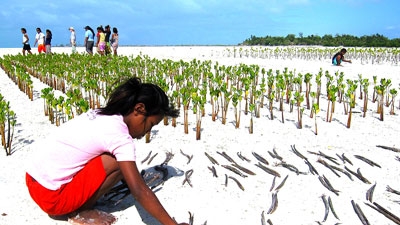Overview
Phase III of the Kiribati Adaptation Program will help strengthen Kiribati’s ability to provide its citizens with safe water and maintain resilient coastal infrastructure in the face of climate change. It builds on the achievements of the first and second Adaptation Projects developed in 2003 and 2006, which piloted a number of critical measures such as mangrove planting, construction of sea walls and rainwater harvesting in selected areas.
Challenge
The Republic of Kiribati consists of 32 low-lying (and one raised) coral islands scattered over 3.5 km2 of sea. It is one of the most vulnerable countries in the world to the effects of climate change. Low atolls, its isolated location, a rising population and the high cost of providing services due to the “tyranny of distance” make Kiribati particularly vulnerable to the adverse impacts of climate change and related natural disasters. Most of the population and infrastructure are concentrated along the coast, and people have already lost their homes as a result of the rise in sea level and coastal erosion.
With prolonged droughts (especially in La Niña years), freshwater supplies can be severely rationed. This means families are unable to access the water they need for survival, wellbeing and livelihoods. Moreover, environmental degradation is having dramatic impacts on the people of Kiribati—infant mortality rates due to diarrhea are the highest in the Pacific. The need to act is urgent. In the absence of adaptation, by 2050 climate change and sea level rises could cause up to US$16 million of economic damages in Kiribati every year, and many villages in the main atoll of Tarawa and most outer islands are at risk of being largely submerged.
Approach
By scaling up measures from previous phases, the Program will work to build resilience to climate change at national, island and community levels, including:
- Improving water use and management by installing groundwater and roof rainwater harvesting systems to ensure cleaner, safer drinking water in selected areas, including during periods of drought; reducing water leakages and waste in existing systems; protecting water reserves, and improving long-term planning for local-level water management.
- Protecting against coastal erosion by investing in protection such as seawalls and mangrove planting at priority sites.
- Strengthening government and community capacity to manage the effects of climate change and natural hazards by supporting the development and adoption of a national Coastal Management Policy, as well as the development and implementation of locally managed Adaptation Plans.
- Supporting and assisting the government in managing, monitoring and evaluating the Program.
By supporting education programs and facilitating the preparation and implementation of locally managed adaptation plans, part of the Program will focus on building skills within communities to manage the effects of climate change and natural hazards. This will be combined with efforts to strengthen institutions and build and maintain stronger infrastructure. The Program supports the government’s National Adaptation Program of Action (2007) and the Kiribati Development Plan (2008-11), which identify improved management of water resources and strengthened coastal resilience as national priorities.
Project locations
The Program will be implemented in North and South Tarawa and selected outer islands of Kiribati.
Bank Contribution
The World Bank's International Development Association (IDA) is administering the funds contributed by various development partners.
Partners
The Program will be implemented by the Office of Te Beretitenti (Office of the President) and the Government of Kiribati is contributing US$0.25 million. Developing partners contributing to the Program are: Government of Australia, US$4.85 million; Global Environmental Facility-Least Developed Country Fund, US$3 million; Japan Policy and Human Resources Development Fund, US$1.8 million; Global Facility for Disaster Reduction and Recovery, US$0.9 million.
Toward the Future
The program is expected to be completed in August 2016 and will benefit 100,900 citizens. By better adapting to effects of climate change, Kiribati can improve water resources and better protect its coast against storm waves and flooding. These adaptation measures will also help the country better manage natural hazards.



